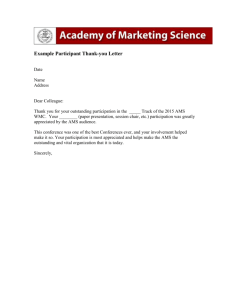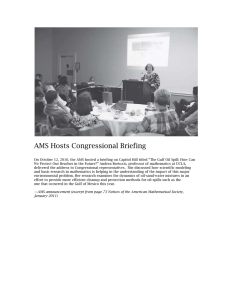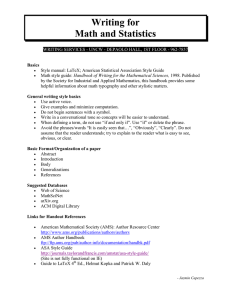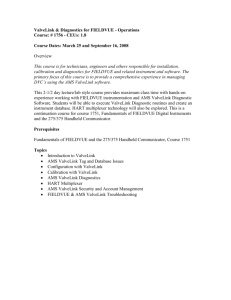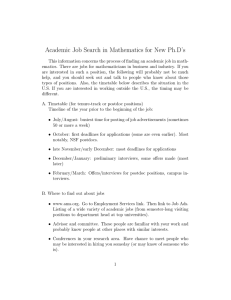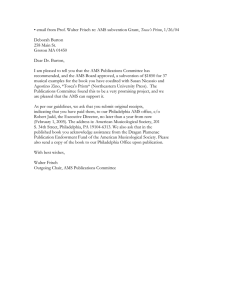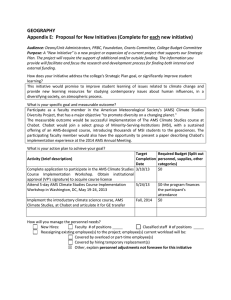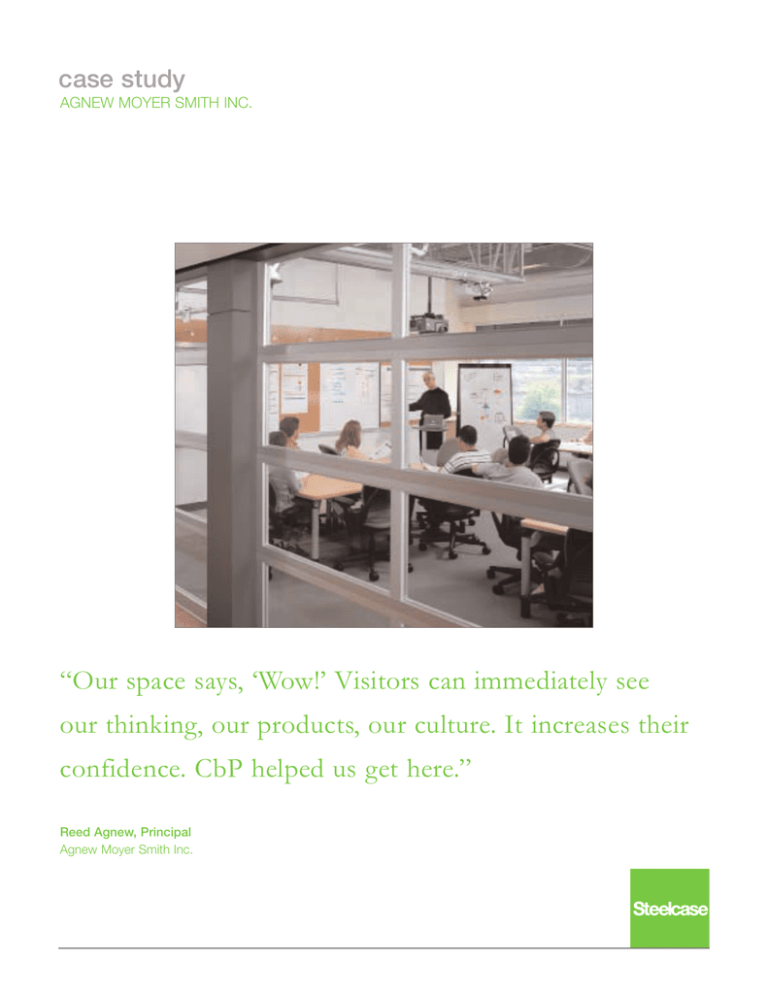
case study
AGNEW MOYER SMITH INC.
“Our space says, ‘Wow!’ Visitors can immediately see
our thinking, our products, our culture. It increases their
confidence. CbP helped us get here.”
Reed Agnew, Principal
Agnew Moyer Smith Inc.
“We took a big
leap, re-engineering
our workplace from
top to bottom.
Naturally, you’d
expect a long period
of adjustment. That
didn’t happen. We hit
the ground running
and haven’t stopped.”
Reed Agnew, AMS Principal
Agnew Moyer Smith Inc.
After more than 20 years of business, the communication
design firm Agnew Moyer Smith Inc. (AMS) was
beginning to f ight its space. Designed just as computers
were entering the industry, the space didn’t support mobile
computing well. It had also failed to keep up with the
firm’s evolving team structure and processes.
A clean break.
Objectives
When AMS learned of a new clear-span loft building on the Monongahela
River in Pittsburgh, the firm seized the opportunity to start with a clean slate.
But if the move were to pay off, the new space would have to serve as a
greater catalyst for AMS’s work process. As a firm whose product is
information, AMS depends entirely on how well its knowledge workers
create, collaborate and communicate.
Situated adjacent to the Monogahela River in Pittsburgh, Pennsylvania, AMS’s new headquarters offered
a blank slate.
Agnew Moyer Smith helps
businesses solve communication problems by making
messages visible. Teams of
knowledge workers apply a
wide range of skills to projects.
AMS builds sophisticated web
sites, creates large-scale
automated publishing systems,
develops electronic learning
curricula, and helps businesses
build strong brands.
Archideas, a Chicagobased firm founded in 1992,
has built a staff of more
than 25 professionals. It’s a
multidisciplinary design firm
committed to creating
insightful, imaginative, and
enduring architectural,
interior, and product
solutions that meet the
business objectives of its
clients.
“We needed a workspace to support what our
people really do day to day.”
Don Moyer, AMS Principal
2
Objectives continued
AMS’s work processes stress a free exchange of ideas, frequent brainstorm
and working sessions, and peer critiques. AMS is also known for its
hospitality—a necessity when clients stay for a day or more, fully immersed
in the work process alongside staff. Clearly this culture called for a design
AMS work processes
are closely intertwined
with the work environment. Clockwise from
top left: progress review
in project room; storyboard session; “driveby” critique; whiteboard
session.
process that could look closely at how the firm works, and then create space
to support these processes. Understanding this, the firm’s interior designer,
Michael Fazio of Archideas, suggested that Steelcase’s Community-based
Planning (CbP) tools could connect AMS’s collaborative
business goals with their space. And CbP’s collaborative
process fit the AMS culture like a glove.
Archideas principal
Michael Fazio
“Our workspace has to help us explore
concepts and explain things to each other,
but it also has to explain AMS to our clients
when they come here—to reveal a true sense
of who we are and how we work.”
Reed Agnew, AMS Principal
3
Three unique CbP tools.
Situation
Archideas began by making a series of extended visits to AMS offices to
gather information and to begin the actual design process together with AMS
staff. They used three unique CbP tools, designed to build spaces that
achieve business results.
1
Observation: Using techniques developed by social anthropologists, the
design team “lives” in the space to see how work really gets done. The team
doesn’t simply compile an inventory of what’s there—they also
seek to understand what’s missing by focusing on the patterns of
interaction and the movement of people and information.
Among the revelations from the
Observation exercises were: largesized storage that was obsolete,
casual meeting places that lacked
worktools, and piles that were slowly
taking over.
Network Analysis:
Using an electronic survey that maps a company’s
informal human networks, CbP creates reports that identify the relative
strengths and weaknesses within those networks. These reports reveal
who the “go-to” people are, how decisions are made, how structured or
Unlike a hierarchy,
networks are made up of
informal relationships that
are based on trust. This
chart shows the interactions between people
for the social network,
one of six networks
examined in the study.
loose work processes are, etc. The
network
analysis
focuses
on
enhancing five critical work issues:
innovation, communication, decision-
2
making, work process, and learning.
This
analysis
reveals
essential
relationship-based insights that an
organizational chart never could.
3
The Power of
Networks
Co-design: Using structured exercises, the
design team brings the space’s future occupants
directly into the design process. They are asked to
articulate ideas, identify needs, set priorities, and
brainstorm solutions together with the designers.
Network Analysis helps select the most
appropriate participants from all staff levels,
especially those who have the most connections
to and the most influence with others.
“We had made mistakes in past
expansions and created spaces
that didn’t support us,” says
AMS HR manager Renee Segar.
“We knew we had to involve the
staff more this time around, and
CbP made that happen.”
All corporations have formal lines of communication based on official hierarchies,
and informal networks based on social ties. “These informal networks are selforganizing structures held in place by relationships of trust,” says Karen
Stephenson, a cultural anthropologist who has pioneered the study of social
networks in organizations. She has shown that understanding them is essential to
strengthening communication and collaboration. Steelcase’s network analysis
tool is based on Stephenson’s research.
4
Situation continued
What did the tools reveal about how the workplace could help AMS achieve
their business goals?
For one thing, the Network Analysis results revealed opportunities to influence
innovation and work process. The social network at AMS was very strong, but
that doesn’t necessarily mean it was healthy. While innovation is a social
activity, not all socialization is productive or leads to innovation. Tightly knit
networks may signal group isolation and a lack of diversity. Network Analysis
helped the design team identify groups that needed more interaction with other
functions within the company, opening channels for more diversity of ideas and
shared learning.
The Network Analysis tool also revealed a highly structured work process at
AMS. While this gives people clear direction, it can also limit innovation if
people become entrenched. AMS wanted to keep work processes clear — but
at the same time encourage people to innovate, embrace new ideas, and take
appropriate risks.
Overall, Archideas, AMS, and Steelcase identified three key business issues
that the new space would address:
1 Expressing the AMS brand by making work visible, and by showcasing
thoughtful workplace innovations.
2 Fostering the sharing of ideas to support innovation and learning.
3 Supporting effective work processes and diverse work styles.
Archideas, Steelcase,
and AMS worked closely
together throughout the
design process. Much of
the design was actually
developed through work
sessions that took place
in AMS offices.
5
Solution continued
Archideas’ final design, shown below, organizes 16,000 square feet along a
continuous corridor; no function is more than a few steps from this “Main
Street.” While the space is slightly smaller than AMS’s previous office,
workstations have an increased number of features, there is support for a
more diverse range of work styles, and the ratio of individual to team space
has been increased from 30% to 55%. So how did this solution fulfill each
of the three key business issues that Archideas and Steelcase identified?
Project Rooms are highpowered team spaces that
provide computer projection, pinup space, and whiteboards.
Privacy can be varied using
sliding or folding doors.
Neighborhoods contain
workspaces grouped according
to AMS disciplines, fostering
knowledge sharing. Each has a
dedicated island for stand-up
meetings.
M
Conference Rooms offer
convenient meeting spaces for
people in the adjacent
neighborhoods.
A
I
N
S
T
Main Conference Room
offers features similar to Project
Rooms, but with more seating
and a dedicated computer.
Garage doors can be raised or
lowered to adjust the degree of
privacy.
R
The Square provides a
hospitable, high-ceilinged space
for informal conferences, lunch,
company-wide meetings, or
client downtime between work
sessions.
E
E
T
Enclaves provide quiet
spaces for concentration and
privacy.
“Seeing Michael’s team gather information and
opinions from everyone in the office, I started to
believe that the new space was really going to fit what
I do, and what everyone else does.”
Lynnette Kelley, AMS Support Team
6
Expressing the brand.
Solution continued
AMS’s expertise is communicating complex and important messages by
making information visual, easy to navigate, and easy to understand. The
firm’s principals wanted clients to see and understand this when they visit
the office. Said Reed Agnew, “Once you understand what we are able to do,
the methods we use, the value we deliver, and the fact that we do it reliably,
time and again…then you understand the AMS brand. We asked the
Archideas team to find a way for our space to communicate this.”
The solution Archideas developed with Steelcase responded to this need on
two levels: explicit and implicit. They created opportunities to display
completed projects by providing large, interchangeable boards along Main
The new Main Street
(left) offers display
surfaces for completed
projects. Project rooms
(right) include modular,
interchangeable
tack/write boards that
keep thinking visible.
Corner windows make
the space more
transparent to visitors.
Street. These displays enable AMS to explain their work to clients in the
relaxed context of an office tour. Archideas also worked with AMS to plan a
display of twelve LCD screens in the Square showing AMS work as well as
snapshots of AMS work process and culture. When complete, the screens
will reinforce the AMS brand to clients as they arrive or while they relax
between meetings.
In addition to these explicit messages, the solution helped reveal the AMS
work process and the implicit statement it makes about the AMS brand.
“The differences have been immediate and apparent. We see more
collaborative work sessions, clients spending more time here, more
work on display and under discussion. Productive conversations
happen at the coffee station. People can get quiet time. Across the
board, I see us getting better results faster.” Don Moyer, AMS Principal
7
Solution continued
The Square, an
informal meeting and
hospitality area, uses
Metro Detour™ lounge
seating to provide a
clean, comfortable
aesthetic. Stitz™ stools
and Cachet™ chairs
support the relaxed
atmosphere.
Modular, interchangeable tack/write boards are integrated throughout the
space to make the AMS process visible. (The boards are also easy to remove
and store when sensitive client information must be concealed.) Archideas
also achieved a high degree of transparency throughout the space. Team
neighborhoods feature an open plan in which
Pathways
®
Post and Beam organizes the
space, supports lighting, and routes utilities.
Enclosed spaces such as project rooms
Project rooms and the
Square are used for
formal and informal
meetings throughout the
day.
feature openable sides and distinctive corner
windows. Wherever clients look, AMS
thinking is on view.
Informal, considerate hospitality is also
important to the AMS brand. One example is the Square, where reception
and lunchroom functions blend. A central, high-bay space with comfortable
Metro Detour seating, Cachet chairs, and refreshments, it creates a true
commons for staff and visitors to cross paths and enjoy casual
conversations over coffee.
Brand Details
The space allows AMS to
express its brand through
both major features and
smaller details. Left, Stitz
stools exemplify AMS’s
unconventional thinking.
Center, RoomWizards
display client names to
make visitors feel
welcome, and assure that
meetings don’t get
interrupted. Right, the
AMS-invented Powerball
unifies Ethernet, power,
sound, and XGA in a pulldown ball for easy laptop
connections. It shows how
CbP lets architects and
clients think outside the box.
8
Fostering idea-sharing.
Solution continued
Centrally located team
islands facilitate
impromptu meetings
where staff can get
input on key issues and
make decisions quickly.
AMS is organized into seven functional groups, which AMS calls discipline
teams. For example, a Project Management team manages budget and
schedules; a Design team creates the form and structure of solutions, and a
Software Engineering team develops code for interactive products. Each
new project is assigned a project team, made up of specialists from the
discipline teams who work closely with each other and the client throughout
the project. A project team typically stays together from as little as a month
to as long as a year.
The CbP exercises confirmed what AMS suspected: people within a project
team needed easier ways to work together. Multimedia presentations were
practical only in one high-demand conference room. Casual meeting spots
were not available throughout the space. And computer network
connections were limited to workstations, so that meetings involving
computer information became impractical.
Before: In AMS’s previous
space (right), group work
was visible but tended to
remain in one place. The
infamous “Save” tag
appeared throughout the
office on markerboards
and tack spaces, making
them unavailable to other
teams for long periods of
time.
High density shelving
compressed archival
storage into a small
footprint, opening up
space that could be
devoted to collaborative
work.
After: In the new space
(right), group work is
mobile. Modular tack/write
boards can be quickly
mounted or removed in
nearly every work area.
Teams take their work
from room to room, take it
to their personal
workspaces, or store it
away until it is needed.
9
Solution continued
In the new space, Archideas placed a much greater emphasis on
collaborative space, increasing the ratio of group to individual space by more
than 80%. They created spaces in a range of sizes to suit different needs,
and worked with AMS to create a range of display and technology features
to facilitate group work. A wireless network and movable display boards
mean that thinking is now portable; teams can quickly move their information
to another space as conditions change. Now any size team can count on
finding the space they need when they need it.
Archideas used CbP tools to resolve
a longstanding AMS debate. Was it
better to have discipline teams sit
together, or project teams? The old
space was a mish-mash, and strong
opinions ran both ways. But network
analysis revealed that while some
overall
networks
were
strong,
discipline teams that were scattered
had weaker networks. Observation
confirmed that members of these
teams were less aware of what fellow members were doing, and weren’t
learning from each other as much. These insights settled the debate. AMS
Flexible, collaborative
workspaces (left) and
enclaves (right).
decided to seat each discipline team together in order to strengthen team
bonds and to increase the sharing of knowledge and learning. Because
adjacency doesn’t ensure communication, islands for stand-up meetings
and peer reviews were integrated with Pathways Post and Beam in each
team neighborhood.
Before: In the previous
space (right), meeting
spaces were limited in
number. Receptionists
tried to direct traffic and
juggle rapidly changing
room reservations and
short-notice requests.
After: In the new space
(right), meeting space is
plentiful. Steelcase
RoomWizards let teams
reserve meeting spaces
ahead or on the spur of the
moment. On the RoomWizard
desktop interface, staff can
see which spaces are
available and when.
10
Supporting the work.
Solution continued
In AMS’s previous space, the typical workstation was 8' x 10', with two very
deep worksurfaces to support the large-format documents that were once
more common to AMS’s work. CPUs sat on the worksurface, dividing it and
consuming its most useful area. It was difficult for two people to work
together with papers, or to both see the screen at once. And much
worksurface sat unused, or simply collected piles of documents.
The solution was smaller, more effectively configured workstations that
support the way AMS works today. By getting worktools, piles, and monitors
off the worksurface, people now have more usable worksurface in a
The new AMS
workstations provide
more features in a
smaller footprint and
better support
collaborative work.
Before: In the previous
space (right), the linear
arrangement of the
worksurface and the fixed
position of computer
monitors made it difficult
for more than two people
to meet at a time.
dramatically smaller footprint. Steelcase’s Answer® system efficiently routes
wires and cables to the worksurface, while a Details Slatwall lets each person
configure their worktools individually. A Details swiveling monitor arm with a
flat screen allows multiple people to view computer-based information.
After: In the new space
(right), workspaces
include mobile tables that
support meetings of three
or more. Two can even be
ganged together for large
meetings. Monitors on
movable arms let groups
share a view of the screen.
11
Solution continued
Smoke™ mobile tables let staff subtly adjust the size and configuration of
their space, and borrow additional worksurface to meet short-term needs.
Leap® chairs provide comfort and boost productivity over the long hours that
8'
10'
AMS staff sometimes puts in. Team islands provide space for stand-up
meetings, and their location at the center of a workstation cluster invites
participation, eavesdropping, and idea-sharing. And as people’s needs
change, they can exchange worktools at the “trading post”, a room of mobile
Before: AMS’s previous
workstations were designed
around large documents
and boxy computers.
furniture and worktools.
In every way, the new workspaces support the individual work process while
opening the process to the constructive exchange that is essential to
encourage new ideas and prevent entrenchment.
6' 6"
6' 9"
In addition to supporting the work process, the new design provided another
huge advantage as well. Taking workstations from 80 square feet to 43.8
square feet opened up valuable space that was put to work as project rooms,
After: The new workstations
provide more flexibility and
functionality in half the
footprint.
conference rooms, and enclaves. As a result, anything that might not get
done in the workstations—from deep solo concentration to boisterous group
collaboration—can get done superbly somewhere in the office.
Each workspace is part
of a neighborhood that
provides storage and
meeting support, as well
as room to spread work
out.
In addition to neighborhoods, work can get done
in more than a dozen
settings that support a
wide variety of processes.
Throughout the office, a
wireless network permits
productive work even
where there is not an
Ethernet port, such as out
on the balcony.
12
Immediate effects.
Results
The immediate impact of the new space is universal. “I love to watch
reactions as clients step off the elevator,” says Lorraine Bridy of the Support
team. “They’re immediately drawn in. I can tell that they secretly want to
wander off and explore.”
Principal Reed Agnew tells how a tour of the new space changed the
perceptions of a longtime AMS client. “I took him into a project room where
a complex project was underway. The walls were covered with detailed
drawings and diagrams. He looked around, turned to me and said, ‘I had no
idea you guys were into all these things!’ ” Sarah Williams, a marketing
consultant and an AMS client commented, “I love to spend time with AMS at
their new space. I enjoy the energy of the team, and I know that whatever I’m
doing, I’ll be comfortable and able to focus.”
More importantly, positive changes to the work process were immediately
apparent to AMS. There’s more collaboration, more opinions are sought and
received, more thinking is on display. “We’ve rediscovered how much design
can take place within a conversation, especially a whiteboard conversation,”
said Don Charlton of the Design team. “And with two or three minds working
AMS’s new space begins to
communicate the right messages
to visitors as soon as they step
off the elevator.
“Our old space was a former industrial loft with wood beams
and exposed brick, and everyone asked how could we leave
behind all that historic charm. I confess to having wondered that
myself. But from the moment I set foot in our new space, I’ve
never looked back. It’s that good.”
Norm Goldberg, AMS Strategy Team
13
Results continued
together, it’s broader, deeper, better design.” Despite many new types of
work environments, all of them were adopted immediately by the staff, and
all remain busy.
Ten months after AMS moved into the new space, the Archideas team and
Steelcase came back to conduct the Post-Occupancy Network Analysis
Evaluation. This tool allows the customer, the design firm, and Steelcase to
measure the success of the project in quantifiable terms. The evaluation
confirmed much of the anecdotal evidence. It showed that networks that
encourage collaboration and innovation are now 14% healthier. Innovation
measures are up 15%, and the effectiveness of work processes is up 37%.
Concludes AMS principal Reed Agnew, “Our space says, ‘Wow!’ Visitors can
immediately see our thinking, our products, our culture. It increases their
confidence. CbP helped us get here.”
60
I
C
70
WP
80
C I
WP
90
DM
DM
Normative Range
L
L
The results of the postoccupancy study showed postoccupancy measures (green)
moving closer to the optimal
zone compared with preoccupancy measures (blue).
The five factors which are
measured and quantified by
the survey are:
Innovation
Communication
Work Process
Decision-Making
Learning
The evaluation showed that networks
that encourage collaboration are now
14% healthier. Innovation measures
are up 15%, and the effectiveness of
work processes is up 37%.
14
Credits
Pathways® Post and Beam
Agnew Moyer Smith Inc.
3700 South Water Street, Suite 300
Pittsburgh, Pennsylvania 15203-2366
Tel: 412.488.8600
www.amsite.com
Answer systems panels and work surfaces
®
Leap® chair
Leap® WorkLounge and Ottoman
Criterion® Chairs
Cachet™ chairs
Wilkahn Stitz™ stools
Brayton Sidewalk™ tables
Archideas Inc.
311 West Superior, Suite 410
Chicago, Illinois 60610
Tel: 312.951.1106
www.archideas.com
Metro Detour™ chairs
Werndl® tables and lecterns
Steelcase 800 Series storage and filing cabinets
Smoke® mobile tables
Franklin Interiors
2740 Smallman Street, Suite 600
Pittsburgh, Pennsylvania 15222
Tel: 412.261.2525
www.franklininteriors.com
Details (Mouse Trays, Worktools, SlatWall)
Lightolier® lighting
Designtex fabrics
RoomWizard™
Many Steelcase customers are benefiting from the CbP design process.
Projects have already been completed with both large and small customers in
various industries: higher education, financial, health care, marketing, telecommunications, travel, research, media, and manufacturing. If you are interested in learning
more about CbP, contact your local Steelcase Market Manager.
Call 800.333.9939 or
visit www.steelcase.com
Item #: 03-0001078 12/04 © 2004 Steelcase Inc. All rights reserved. All specifications subject to change without notice. Trademarks used herein are the property of Steelcase Development Corporation or of their respective owners.
Steelcase products used:

